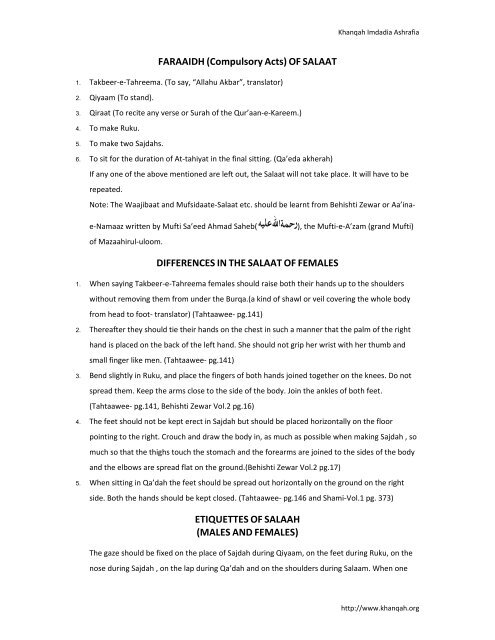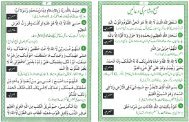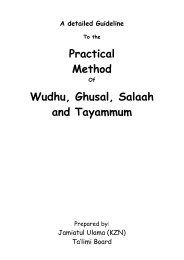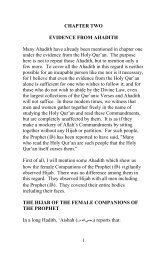This book is a revised edition by Khanqah Imdadia Ashrafia of the ...
This book is a revised edition by Khanqah Imdadia Ashrafia of the ...
This book is a revised edition by Khanqah Imdadia Ashrafia of the ...
Create successful ePaper yourself
Turn your PDF publications into a flip-book with our unique Google optimized e-Paper software.
<strong>Khanqah</strong> <strong>Imdadia</strong> <strong>Ashrafia</strong><br />
FARAAIDH (Compulsory Acts) OF SALAAT<br />
1. Takbeer‐e‐Tahreema. (To say, “Allahu Akbar”, translator)<br />
2. Qiyaam (To stand).<br />
3. Qiraat (To recite any verse or Surah <strong>of</strong> <strong>the</strong> Qur’aan‐e‐Kareem.)<br />
4. To make Ruku.<br />
5. To make two Sajdahs.<br />
6. To sit for <strong>the</strong> duration <strong>of</strong> At‐tahiyat in <strong>the</strong> final sitting. (Qa’eda akherah)<br />
If any one <strong>of</strong> <strong>the</strong> above mentioned are left out, <strong>the</strong> Salaat will not take place. It will have to be<br />
repeated.<br />
Note: The Waajibaat and Mufsidaate‐Salaat etc. should be learnt from Beh<strong>is</strong>hti Zewar or Aa’inae‐Namaaz<br />
written <strong>by</strong> Mufti Sa’eed Ahmad Saheb(<br />
<strong>of</strong> Mazaahirul‐uloom.<br />
), <strong>the</strong> Mufti‐e‐A’zam (grand Mufti)<br />
DIFFERENCES IN THE SALAAT OF FEMALES<br />
1. When saying Takbeer‐e‐Tahreema females should ra<strong>is</strong>e both <strong>the</strong>ir hands up to <strong>the</strong> shoulders<br />
without removing <strong>the</strong>m from under <strong>the</strong> Burqa.(a kind <strong>of</strong> shawl or veil covering <strong>the</strong> whole body<br />
from head to foot‐ translator) (Tahtaawee‐ pg.141)<br />
2. Thereafter <strong>the</strong>y should tie <strong>the</strong>ir hands on <strong>the</strong> chest in such a manner that <strong>the</strong> palm <strong>of</strong> <strong>the</strong> right<br />
hand <strong>is</strong> placed on <strong>the</strong> back <strong>of</strong> <strong>the</strong> left hand. She should not grip her wr<strong>is</strong>t with her thumb and<br />
small finger like men. (Tahtaawee‐ pg.141)<br />
3. Bend slightly in Ruku, and place <strong>the</strong> fingers <strong>of</strong> both hands joined toge<strong>the</strong>r on <strong>the</strong> knees. Do not<br />
spread <strong>the</strong>m. Keep <strong>the</strong> arms close to <strong>the</strong> side <strong>of</strong> <strong>the</strong> body. Join <strong>the</strong> ankles <strong>of</strong> both feet.<br />
(Tahtaawee‐ pg.141, Beh<strong>is</strong>hti Zewar Vol.2 pg.16)<br />
4. The feet should not be kept erect in Sajdah but should be placed horizontally on <strong>the</strong> floor<br />
pointing to <strong>the</strong> right. Crouch and draw <strong>the</strong> body in, as much as possible when making Sajdah , so<br />
much so that <strong>the</strong> thighs touch <strong>the</strong> stomach and <strong>the</strong> forearms are joined to <strong>the</strong> sides <strong>of</strong> <strong>the</strong> body<br />
and <strong>the</strong> elbows are spread flat on <strong>the</strong> ground.(Beh<strong>is</strong>hti Zewar Vol.2 pg.17)<br />
5. When sitting in Qa’dah <strong>the</strong> feet should be spread out horizontally on <strong>the</strong> ground on <strong>the</strong> right<br />
side. Both <strong>the</strong> hands should be kept closed. (Tahtaawee‐ pg.146 and Shami‐Vol.1 pg. 373)<br />
ETIQUETTES OF SALAAH<br />
(MALES AND FEMALES)<br />
The gaze should be fixed on <strong>the</strong> place <strong>of</strong> Sajdah during Qiyaam, on <strong>the</strong> feet during Ruku, on <strong>the</strong><br />
nose during Sajdah , on <strong>the</strong> lap during Qa’dah and on <strong>the</strong> shoulders during Salaam. When one<br />
http://www.khanqah.org








